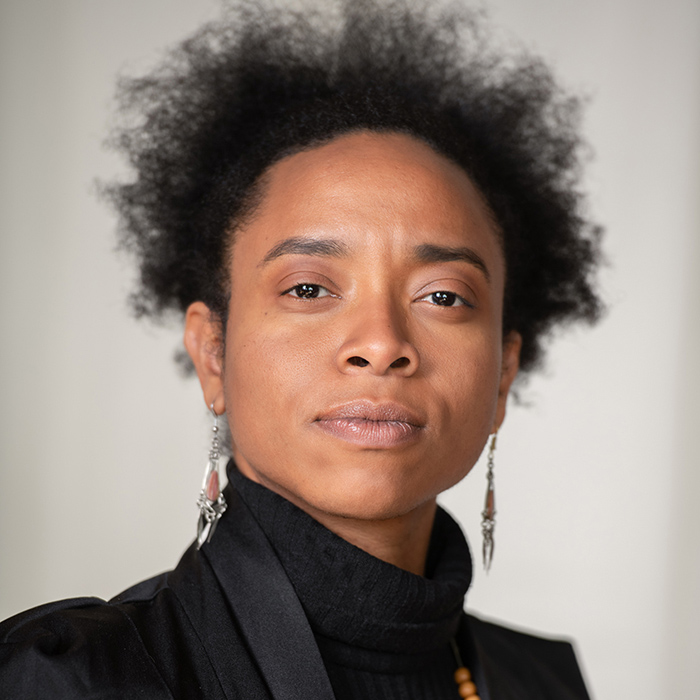Snapchat lens by TU’s Ada Pinkston uses augmented reality to highlight marginalized stories
Exhibition from Los Angeles County Museum of Art and Snapchat uses AR to explore monuments, representation and history
By Rebecca Kirkman on April 16, 2021
In Los Angeles’ Earvin "Magic" Johnson Park, visitors hold up their phones to view an augmented-reality (AR) monument to Biddy Mason, a formerly enslaved Black woman who became a real estate entrepreneur and philanthropist in L.A.
In the Snapchat lens “The Open Hand is Blessed,” Towson University art education lecturer Ada Pinkston draws from archival images of African American residents in 19th century Los Angeles to create a virtual memorial series that pays tribute to Mason’s voice and spiritual philosophy.
Pinkston is one of five artists selected by the Los Angeles County Museum of Art (LACMA) for its new interactive initiative “LACMA x Snapchat: Monumental Perspectives” bringing together artists and technologists to create new AR monuments to celebrate diverse histories in an effort to reflect richer and more inclusive perspectives from communities across the region.

Launched on April 13, this initiative pairs established and emerging artists with members of Snap's Lens Creator community to bring their shared visions to life. The first group of artists—Pinkston, I. R. Bach, Mercedes Dorame, Glenn Kaino and Ruben Ochoa—created site-specific AR monuments or murals in consultation with community leaders and historians to examine key moments and figures in the region's past and present that have too-often been overlooked.
The exhibition ties into Pinkston’s past work surrounding monuments, including her 2018 project “Landmarked,” which reimagined the use for spaces where Confederate monuments once stood. Hear more from Pinkston in the College of Fine Art & Communication’s theme podcast series, “The ROARing Twenties.”
We caught up with Pinkston to hear more about her work and the inspiration for “The Open Hand is Blessed.”
Q&A with Ada Pinkston
Why did you choose Biddy Mason as the subject of your lens?
I wanted the center of my lens to be of a Black woman who is often ignored in dominant narratives of the past. The call was to make a digital monument that was specific to Los Angeles. Her story of liberation is unique. There is a memorial that recognizes her in downtown Los Angeles, but it is not easily accessible to pedestrians.
The story of Biddy Mason and her journey to freedom and eventual acquisition of wealth is based on resilience. She was an enslaved woman who walked from Mississippi to Utah and then from Utah to California. Once she arrived in California, she petitioned for the freedom of herself, her family and all the other people with whom she was enslaved with. Her story is not widely known in Los Angeles, in California or in the United States. This intentional exclusion is what my work aims to address.
What do you hope viewers take away from your work for this exhibition?
I hope that viewers are inspired as they learn a story from the past about a Black woman in the United States that is centered on redemption and a steady movement towards liberation.
We typically think of monuments as permanent objects made of stone or marble—how does AR change how you think about monuments?
Architectural public objects that are monuments generally exclude the narratives of women in the United States. They also exclude the narratives of Black people in the United States.
The aim of this project was to fill that gap. The title of this AR monument “The Open Hand" honors the acts of service that Biddy Mason provided for her community when she was alive.
Monuments have always been fabricated in response to the technologies of the time.
AR has a lot more flexibility than the brick-and-mortar structures that we see today in public space. It provides a possibility to engage a broad public with an image, concept or idea. It is also ephemeral and geotags make it so that a multiplicity of digital experiences can be had in one place. The fabrication of monuments has always been brokered by very specific interests and power structures. AR has the potential to continue to democratize public space as it requires less resources to produce.
How do you bring this experience back to your TU students?
I am currently teaching a course entitled Engaging Public Sites. The course is centered on providing students with a space to respond to historical sites in Maryland by creating designs for site-specific artworks and collaborative art workshops for P-12 and other audiences. In this class, the aim is to provide students with space to deeply research and creatively respond to stories from the past in the state of Maryland that are often lost through the folds of dominant narratives. This semester, we are working with the Hampton National Historic Site.
Try it at home
Experience Pinkston's Snap lens from anywhere by downloading Snapchat and scanning the Snap code.